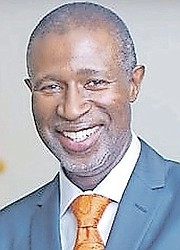By NEIL HARTNELL
Tribune Business Editor
nhartnell@tribunemedia.net
Aliv’s top executive yesterday said August was the highest revenue-generating month in the mobile operator’s history as it bids to dominate market share by end-June 2022.
John Gomez, who took over Aliv’s leadership from Damian Blackburn barely four months ago, told Tribune Business it aimed to convince subscribers it was “more than a mobile app” but a platform they can use to enter a “smart” future where various apps run different elements in their daily lives.
With 178,000 subscribers presently as competition with the Bahamas Telecommunications Company (BTC) intensifies, he added that Aliv was already in the initial stages of costing and planning the transition to 5G (fifth generation) technology.
While declining to provide figures on the investment required, as the details are still being worked out, Mr Gomez said the sum required for a transition likely to happen in two years’ time will be equivalent to “rebuilding your entire network”.
He added that Aliv was generating favourable revenue trends despite roaming income that was off 25 percent against pre-COVID levels due to a tourism industry that is still rebounding in terms of visitor numbers, while fewer Bahamians are also travelling abroad.
Declining to provide figures as BISX-listed Cable Bahamas, Aliv’s 48.25 percent controlling shareholder, is in a closed period ahead of publishing its results for the year to end-June 2021, Mr Gomez nevertheless told this newspaper: “We have hit our highest numbers in any given month in the history of the business despite COVID-19.
“August was the highest amount of revenues in the history of the business. September is looking similar; not like August, but higher than in the past, and we’ve seen that trend in the last three months despite the challenges with the economy.
“We’re still feeling the impact of the pandemic. For example, roaming - although tourists are coming back - we still don’t have the volume of tourists travelling, so we are missing that side of the business quite substantially. As things settle down with COVID variants, hopefully more people will travel and there will be a positive uptick for us there,” Mr Gomez added.
“I would say we are still maybe about 75 percent back on roaming revenues. There are Bahamians travelling about as well, but it is below the targets we have set for ourselves.” Roaming revenues are generated whenever Aliv customers use their phones or abroad, or tourists and visitors use the operator’s network to make calls while in The Bahamas.
Looking ahead, Mr Gomez added that the transition to 5G mobile networks and technology is “on the horizon” and “maybe one, two years out”. He said: “We are starting to look at it, have conversations and look at timelines. The main factor is cost; the cost of upgrading the network to 5G.”
With mobile communications equipment and devices now being manufactured for 5G platforms, the Aliv chief said the Bahamian operator has little choice but to move. “We’ve got back-of-the-napkin type of stuff, but don’t want to quote anything until we get hard numbers,” Mr Gomez added.
“It’s going to be a real tidy sum. It’s going to be like rebuilding an entire network. We should have hard numbers in a few weeks. The business moves very rapidly, but at the same time we need to stay ahead of the curve so we provide a service that clients are willing to pay for.” Aliv’s current network took between $200m-$250m to build-out nationwide.
Mr Gomez said Aliv was looking to innovation, and the introduction of new mobile apps, to help attract long-standing BTC customers to it. With subscribers challenged by unemployment and COVID-19’s devastating impact, he added: “We have customer churn back and forth as we offer promotions and the competitor does the same thing.
“The last five years for us, by reaching 48 percent market share, the loyal ones are embedded. That will be the next part of our story; winning over those customers to join our network as well. That’s where innovation comes in for us, looking at technology and different ways to use the device differently through apps put in place.”
Smart homes, where mobile devices were used to activate air conditioning and other functions before a subscriber returned home, smart or tele-medicine and education were all areas where Aliv was focused, Mr Gomez added.
“We’re looking at those avenues to drive the innovation and get customers to recognise there is more value underneath the service we provide rather than just a phone service,” he said. “That’s the only way; innovation. It’s more than a mobile app; it’s a platform you can use to do so many things.
“We’re just hovering below 180,000 subscribers at 178,000. We’re never satisfied. We want to grow that number. They are the two drivers for us right now; to grow market share and improve revenue and average revenue per unit (ARPU).” The latter, which means average revenue per subscriber, stands at $28.
With Aliv harbouring ambitions to become market share leader by end-June 2022, Mr Gomez said the mobile operator was focused on eliminating network congestion in the Carmichael area on New Providence and in Abaco as businesses and residents came back online post-Dorian.
He added that Aliv had seen no growth in demand for its broadband services this year due to students returning to the classroom, while companies were now calling more workers back to the office as COVID-19 restrictions eased.





Comments
Use the comment form below to begin a discussion about this content.
Sign in to comment
Or login with:
OpenID